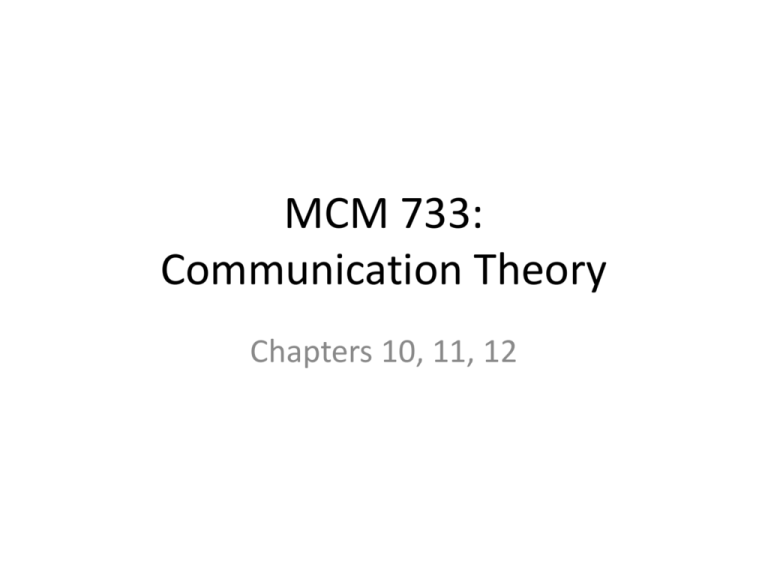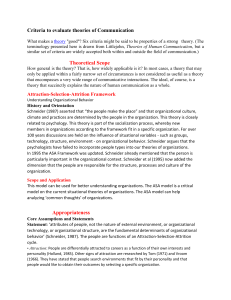MCM 733: Communication Theory
advertisement

MCM 733: Communication Theory Chapters 10, 11, 12 CH 10: Media and Society • Information/Innovation diffusion theory: explains how innovations are introduced and adopted by various communities – First, awareness raising – Second, adopted by early adopters (people who adopt techs early, without all the consumer info) – Third, opinion leaders adopt it based on early adopters experiences – Fourth, opinion leaders spread it to their constituencies – Fifth, laggards adopt it – Change agents: those wo directly influence the adoption process CH 10: Media and Society • Media System Dependency Theory: – The more people use media, the more they become dependent on it and the more influence the media will have in their lifes • Knowledge Gap Theory: – There are systematic gaps between better informed and less-informed members of a population. This is a demonstration of the power of systems theory CH 10: Media and Society • Agenda Setting Theory: – Communicators don’t tell people what to think, rather they encourage them to prioritize their values. – Priming: media draw attention to some aspects of political life at the expense of others – Agenda Building: collective process in which media, gov’t and the citizenry reciprocally influence one another in areas of public policy CH 10: Media and Society • Elements of Agenda Setting Theory: – Mass comm has a huge effect on setting people’s priorities – Vividness of presentation – Position of a story – priming CH 10: Media and Society • Framing Theory: the idea that people use sets of expectations to make sense of their social world and media contribute to those expectations • Second-order agenda setting: media set the public’s agenda at a second level or order – the attribute level, where the first order was the object level. • Frame: a specific set of expectations used to make sense of some aspect of the social world in a specific situation and time CH 10: Media and Society • Spiral of Silence Theory: people holding views contrary to dominant views are moved to keep them to themselves for fear of rejection • Three factors that lead to Spiral of Silence: – Ubiquity: the media are virtually everywhere as sources of information – Cumulation: the various news media tend to repeat stories and perspectives across their different individual programs, or editions, across the different media themselves – Consonance: the similarity of values held by newspeople influences the content they produce CH 10: Media and Society • New Production Research: the study of how the institutional routines of news production inevitably produce bias or distorted content – Personalized News: most news stories center around people – Dramatized News: storylines dominate – Fragmented news: news is made up of a lot different fragments – Normalized News: adding th threat of disaster to a sense of normalcy – Objectivity rituals: rituals that ensure objectivity but reinforce the status quo CH 10: Media and Society • Media Intrusion Theory: – The idea that the media have taken over politics to the extent that politics have become subverted. • Social Capital – Membership in certain social groups confers status and prestige to an individual Ch 11: Media and Culture Theories • Symbolic Interactionism: people give meaning to certain things and those meanings end up controlling them • Social behaviourism: view of learning that focuses on the mental processes and the social environment in which learning takes place Ch 11: Media and Culture Theories • Applications of Symbolic Interactionism – People’s interpretation and perception of the environment depend on communication – Communication is guided by and guides the concepts of self, role, and situations. These concepts generate expectations in and of the environment – Communication consists of complex interactions “involving action, interdependence, mutual influence, meaning, relationship, and situational factors.” Ch 11: Media and Culture Theories • Social Constructionism: individuals’ power to control or change their environment is limited • Social construction of reality: we construct meaning together in an on-going fashion because people share a common sense of its reality Ch 11: Media and Culture Theories • Some concepts for social interactionism and constructionism: – Signals: artificial signs that produce predicable responses – Signs: something represents something else • Artificial signs: made by people • Natural signs: thunder, lightning, etc. – Symbols: artificial signs for which there is less certainty of response – Typifications: mental images that allow people to quickly classify objects and actions and then structure their own actions in response. Ch 11: Media and Culture Theories • Framing and Frame Analysis – Framing: people use expectations to make sense of everyday life – Social cues: info in the environment that signals a shift or change of action – Frame: a specific set of expectations used to make sense of a social situation at a given point in time – Downshift and upshift: to move back and forth between more or less serious frames – Hyper-ritualized representations: media content constructed to highlight only the most meaningful representations – Primary reality: the real world in which people obey conventions and laws Ch 11: Media and Culture Theories • Cultivation Analysis: media cultivates a reality, that may be untrue, but becomes reality because people believe it to be so • Violence Index: annual content analysis of a sample week of network television to measure amount of violence contained in it Ch 11: Media and Culture Theories • Cultural Indicators Project: periodic examinations of television programming and the conceptions of social reality cultivated by viewing – Television is different from all other forms of mass media – TV is the central cultural arm of today’s society – Audience consciousness is cultivated by keying into basic assumptions about the “facts of life” and “common sense” rather than “high concept” ideas – TV’s major cultural function is to stabilize social patterns, to cultivate resistance to change – The observable, measurable independent contributions of television to the culture are relatively small. It is rather it’s stable contribution that matters (Ice Age Hypothesis) Ch 11: Media and Culture Theories • Products of Cultivation Analysis – Message systems analysis: detailed content analysis of TV programming to assess recurring and consistent messaging – Cultivation: television’s contribution to the creation of a culture’s frameworks or knowledge and underlying general concepts – Mainstreaming: the process, especially for heavier viewers, by which TVs symbols monopolize and dominate other sources of info and ideas about the world – Resonance: when viewers see things on TV that are congruent with their own everyday realities Ch 11: Media and Culture Theories • Mean World Index: a series of questions about the incidence of crime and violence, the answer to which can be used to differentiate heavy and light viewers • The Three B’s of TV: – Television blurs traditional distinctions of people’s views of their world – TV blends their realities into TV’s cultural mainstream – TV bends that mainstream to the institutional interests of television and its sponsors Ch 11: Media and Culture Theories • Commodification of Culture: – When elements of everyday culture are selected for repackaging, only a very limited range is chosen and important elements are overlooked or consciously ignored – The repackaging process involves dramatization of those elements of culture that have been selected – The marketing of cultural commodities is undertaken in a way that maximizes the likelihood that they will intrude into and ultimately disrupt everyday life – The elites who operate the cultural industries are generally ignorant of the consequences of their work. – Disruption of everyday life takes many forms – some disruptions are obviously linked to consumption of deleterious content, other are subtle and take a long time. Ch 11: Media and Culture Theories • Media Literacy Movement – An awareness of the impact of the media on the individual and society – An understanding of the process of mass communication – The development of strategies with which to analyse and discuss media messages – An awareness of media content as a “text” that provides insight into our contemporary culture and ourselves – The cultivation of an enhanced enjoyment, understanding and appreciation of media content Ch 12: The Future of Media Theory and Research • The End of Mass Comm Theory and the Beginning of Media Theory – Web 2.0 – iPhone/Blackberry – Virtual reality – Artificial intelligence – Cognitive neuroscience – Globalization





